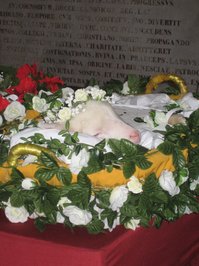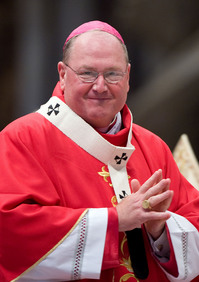 Agnes beatæ virginis
Agnes beatæ virginis
natalis est, quo spiritum
cælo refudit debitum
pio sacrata sanguine.
Matura martyrio fuit
matura nondum nuptiis;
prodire quis nuptum putet,
sic læta vultu ducitur.
Aras nefandi numinis
adolere tædis cogitur;
respondet: «Haud tales faces
sumpsere Christi virgines.
Hic ignis exstinguit fidem,
hæc flamma lumen eripit;
hic, hic ferite, ut profluo
cruore restinguam focos».
Percussa quam pompam tulit!
Nam veste se totam tegens,
terram genu flexo petit
lapsu verecundo cadens.
Iesu, tibi sit gloria,
qui natus es de Virgine,
cum Patre et almo Spiritu,in sempiterna sæcula.
(Saint Ambrose)
Almighty and eternal God, Who did choose the weak things of the world to confound the strong, mercifully grant, that we who celebrate the solemnity of blessed Agnes, Thy Virgin and Martyr, may experience her intercession with Thee.
 Church has remembered Saint Anges, who died in 305, since 354 in the sacred Liturgy, poetry and art. This ancient feast retains a custom of blessing of the wool of two lambs brought to the pope from the Trappist Abbey of Tre Fontane. The wool from the lambs is given to the nuns to weave the pallia. The pallia spend some time at the relics of Saint Peter below the main altar of Saint Peter's Basilica showing a special unity between the Pontiff and the archbishop. The pallium is a white woolen band embroidered with six black crosses worn over the shoulders and has two hanging pieces, front and back. Since the 9th century, the pallium has wider use and is worn by the pope and by metropolitan archbishops symbolizing authority and expresses the special bond of unity between the archbishop and the Roman Pontiff. Pallia are given, upon request from by the metropolitan archbishops on the Solemnity of Saint Peter and Paul by the pope. The pallium is worn by the archbishop in his diocese and when necessary, in the other diocese in the Metropolitanate and is generally worn only for significant ecclesial events like the blessing of Chrism, ordinations, consecration of altars and not for daily and Sunday Mass.
Church has remembered Saint Anges, who died in 305, since 354 in the sacred Liturgy, poetry and art. This ancient feast retains a custom of blessing of the wool of two lambs brought to the pope from the Trappist Abbey of Tre Fontane. The wool from the lambs is given to the nuns to weave the pallia. The pallia spend some time at the relics of Saint Peter below the main altar of Saint Peter's Basilica showing a special unity between the Pontiff and the archbishop. The pallium is a white woolen band embroidered with six black crosses worn over the shoulders and has two hanging pieces, front and back. Since the 9th century, the pallium has wider use and is worn by the pope and by metropolitan archbishops symbolizing authority and expresses the special bond of unity between the archbishop and the Roman Pontiff. Pallia are given, upon request from by the metropolitan archbishops on the Solemnity of Saint Peter and Paul by the pope. The pallium is worn by the archbishop in his diocese and when necessary, in the other diocese in the Metropolitanate and is generally worn only for significant ecclesial events like the blessing of Chrism, ordinations, consecration of altars and not for daily and Sunday Mass.



Leave a comment